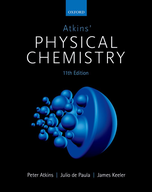?The energy levels of N atoms in the tight-binding Hückel approximation are the roots of
Chapter 15, Problem P15C.6(choose chapter or problem)
The energy levels of N atoms in the tight-binding Hückel approximation are the roots of a tridiagonal determinant (eqn 15C.1):
\(E_{k}=\alpha+2 \beta \cos \frac{k \pi}{N+1}\) \quad \(k=1,2, \ldots, N\)
If the atoms are arranged in a ring, the solutions are the roots of a ‘cyclic’ determinant:
\(E_{k}=\alpha+2 \beta \cos \frac{2 k \pi}{N}\) \quad \(k=0, \pm 1, \pm 2, \ldots, \pm \frac{1}{2} N\)
(for N even). Discuss the consequences, if any, of joining the ends of an initially straight length of material.
Text Transcription:
E_k=alpha+2 beta cos k pi/N+1
k=1,2, ldots, N
E_k=alpha+2 beta cos 2k pi/N
k=0, pm 1, pm 2, ldots, pm1/2 N
Unfortunately, we don't have that question answered yet. But you can get it answered in just 5 hours by Logging in or Becoming a subscriber.
Becoming a subscriber
Or look for another answer
